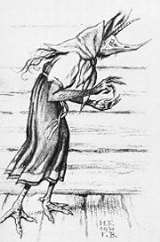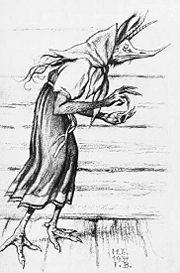
Kikimora
Encyclopedia

Legendary creature
A legendary creature is a mythological or folkloric creature.-Origin:Some mythical creatures have their origin in traditional mythology and have been believed to be real creatures, for example the dragon, the unicorn, and griffin...
, a female house spirit in Slavic
Slavic peoples
The Slavic people are an Indo-European panethnicity living in Eastern Europe, Southeast Europe, North Asia and Central Asia. The term Slavic represents a broad ethno-linguistic group of people, who speak languages belonging to the Slavic language family and share, to varying degrees, certain...
mythology
Mythology
The term mythology can refer either to the study of myths, or to a body or collection of myths. As examples, comparative mythology is the study of connections between myths from different cultures, whereas Greek mythology is the body of myths from ancient Greece...
, fin: Kikke Mörkö (sve: Mårran), sometimes said to be married to the Domovoi
Domovoi
A domovoi or domovoy is a house spirit in Slavic folklore. The plural form in Russian can be transliterated domoviye or domovye ....
. She usually lives behind the stove or in the cellar of the house she haunts.
When construction workers were unhappy with the home owners and wanted to do something harmful, they could introduce Kikimora into the house they were building by making a doll in her fashion and place it under the main beam or under the front corner of the house. Once in the house, it is difficult to get rid of her.
The word "kikimora" allegedly derives from a phrase meaning "malicious spirit of Mara
Mara
-Social groups:*Mara people, in northeastern India and western Myanmar* Mara language, a language spoken by Mara people*Mara Salvatrucha, a violent criminal gang in Mexico, Central America, Canada, and the United States...
."
There are two different kinds of Kikimoras. One lives in the forest and another kind lives in the swamp. Swamp Kikimora is the wife of Leshy. Her presence can be recognized by wet footprints.
In some tales, she looks like an average woman with her hair down. (Married Slavic women typically kept their hair covered, and young unmarried girls kept it braided.) She may also be described as a small humpbacked woman in dirty clothes.
Kikimora is said to look after the chickens and the housework if the home is well-kept. If not, she will whistle, break dishes and makes noise at night. She also comes out at night to spin
Spinning (textiles)
Spinning is a major industry. It is part of the textile manufacturing process where three types of fibre are converted into yarn, then fabric, then textiles. The textiles are then fabricated into clothes or other artifacts. There are three industrial processes available to spin yarn, and a...
. It is said that a person who sees Kikimora spinning will soon die. To appease an angry Kikimora, one should wash all the pots and pans with fern tea. An adder stone
Adder stone
Adder stone is a type of stone, usually glassy, with a naturally occurring hole through it. Such stones have been discovered by archaeologists in both Britain and Egypt....
or a bunch of juniper
Juniper
Junipers are coniferous plants in the genus Juniperus of the cypress family Cupressaceae. Depending on taxonomic viewpoint, there are between 50-67 species of juniper, widely distributed throughout the northern hemisphere, from the Arctic, south to tropical Africa in the Old World, and to the...
twigs is hung above the nesting place of chickens to protect their eggs from Kikimora.
The Kikimora is the subject of a fairy tale
Fairy tale
A fairy tale is a type of short story that typically features such folkloric characters, such as fairies, goblins, elves, trolls, dwarves, giants or gnomes, and usually magic or enchantments. However, only a small number of the stories refer to fairies...
for orchestra
Orchestra
An orchestra is a sizable instrumental ensemble that contains sections of string, brass, woodwind, and percussion instruments. The term orchestra derives from the Greek ορχήστρα, the name for the area in front of an ancient Greek stage reserved for the Greek chorus...
by Anatoly Lyadov, who says, as recounted by a Los Angeles Philharmonic program note, that she "grows up with a magician in the mountains. From dawn to sunset the magician’s cat regales Kikimora with fantastic tales of ancient times and faraway places, as Kikimora rocks in a cradle made of crystal. It takes her seven years to reach maturity, by which time her head is no larger than a thimble and her body no wider than a strand of straw. Kikimora spins flax from dusk and to dawn, with evil intentions for the world."
Marsh Kikimora is featured in the animal world - in 1988 Kirill Eskov named a genus
Genus
In biology, a genus is a low-level taxonomic rank used in the biological classification of living and fossil organisms, which is an example of definition by genus and differentia...
from the Linyphiidae
Linyphiidae
Linyphiidae is a family of spiders, including more than 4,300 described species in 578 genera worldwide. This makes Linyphiidae the second largest family of spiders after the Salticidae. New species are still being discovered throughout the world, and the family is poorly known...
spider
Spider
Spiders are air-breathing arthropods that have eight legs, and chelicerae with fangs that inject venom. They are the largest order of arachnids and rank seventh in total species diversity among all other groups of organisms...
family discovered by him Kikimora palustris, after this spirit in Slavic mythology
Slavic mythology
Slavic mythology is the mythological aspect of the polytheistic religion that was practised by the Slavs before Christianisation.The religion possesses many common traits with other religions descended from the Proto-Indo-European religion....
.
The Kikimora is mentioned in Book 3 of the Ringing Cedars Series by Vladimir Megre
Vladimir Megre
Vladimir Megre is a Siberian entrepreneur from Novosibirsk, and founder of the Anastasia/"Ringing Cedars" movement.-Background:...
, who likens a man who marries unwisely based on looks and fashion as to as if he married a kikimora. Footnote in the English version describes the Kikimora as a malevolent female ghost said to attach itself to a particular house and disturb the inhabitants, males in particular. By extension, the term may also suggest an ugly woman in shabby clothing, ill-tempered and grumbling, striving to make life of her husband (and men in general) unbearable.

